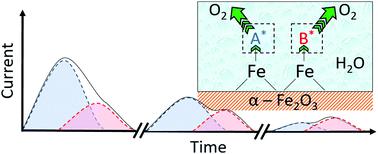当前位置:
X-MOL 学术
›
Energy Environ. Sci.
›
论文详情
Our official English website, www.x-mol.net, welcomes your feedback! (Note: you will need to create a separate account there.)
Parallel water photo-oxidation reaction pathways in hematite photoanodes: implications for solar fuel production
Energy & Environmental Science ( IF 32.5 ) Pub Date : 2022-04-29 , DOI: 10.1039/d1ee03953a Anton Tsyganok 1 , Paulino Monroy-Castillero 2 , Yifat Piekner 3 , Arik Yochelis 2, 3 , Avner Rothschild 1, 4
Energy & Environmental Science ( IF 32.5 ) Pub Date : 2022-04-29 , DOI: 10.1039/d1ee03953a Anton Tsyganok 1 , Paulino Monroy-Castillero 2 , Yifat Piekner 3 , Arik Yochelis 2, 3 , Avner Rothschild 1, 4
Affiliation

|
Water photo-oxidation on stable metal-oxide photoanodes presents a critical challenge for solar fuel production. This reaction is widely considered to proceed in a sequential pathway with four stepwise hydroxide-coupled hole transfer steps, resulting in oxidized surface intermediates that trap holes while their adsorbates change forms (e.g., from –OH to ![[double bond, length as m-dash]](https://www.rsc.org/images/entities/char_e001.gif) O to –OOH and back to –OH) so as to maintain charge neutrality. Here we study the potentiodynamic discharge characteristics of hematite photoanodes following polarization under water photo-oxidation conditions. Upon turning the light off, some of the oxidized intermediates discharge spontaneously whereas others remain oxidized for a while. The metastable intermediates discharge in a double-peak wave during cathodic potential sweep (in the dark). The relative peak heights were found to reverse after long time delays since turning the light off. This unexpected observation indicates that the discharge proceeds in parallel pathways, suggesting the same for the reverse reaction that leads to water photo-oxidation. Complementary photoelectrochemical impedance spectroscopy measurements display distinct charge transfer features, supporting the prevalence of parallel pathways in the water photo-oxidation reaction. Through a micro-kinetic model, we derive a criterion that explains why peak reversal, as observed in our measurements, can emerge only from parallel pathways. The prevalence of parallel pathways fundamentally broadens the current paradigm of the water photo-oxidation reaction mechanism, and it may inspire new strategies to reduce the high overpotential of this reaction so as to enhance the efficiency of solar fuel production.
O to –OOH and back to –OH) so as to maintain charge neutrality. Here we study the potentiodynamic discharge characteristics of hematite photoanodes following polarization under water photo-oxidation conditions. Upon turning the light off, some of the oxidized intermediates discharge spontaneously whereas others remain oxidized for a while. The metastable intermediates discharge in a double-peak wave during cathodic potential sweep (in the dark). The relative peak heights were found to reverse after long time delays since turning the light off. This unexpected observation indicates that the discharge proceeds in parallel pathways, suggesting the same for the reverse reaction that leads to water photo-oxidation. Complementary photoelectrochemical impedance spectroscopy measurements display distinct charge transfer features, supporting the prevalence of parallel pathways in the water photo-oxidation reaction. Through a micro-kinetic model, we derive a criterion that explains why peak reversal, as observed in our measurements, can emerge only from parallel pathways. The prevalence of parallel pathways fundamentally broadens the current paradigm of the water photo-oxidation reaction mechanism, and it may inspire new strategies to reduce the high overpotential of this reaction so as to enhance the efficiency of solar fuel production.
中文翻译:

赤铁矿光阳极中的平行水光氧化反应途径:对太阳能燃料生产的影响
稳定的金属氧化物光阳极上的水光氧化是太阳能燃料生产的关键挑战。该反应被广泛认为以连续途径进行,具有四个逐步的氢氧化物偶联空穴转移步骤,导致氧化的表面中间体捕获空穴,同时它们的吸附物改变形式(例如,从 -OH 到![[双键,长度为 m-dash]](https://www.rsc.org/images/entities/char_e001.gif) O 到 -OOH 并返回到 -OH) 以保持电荷中性。在这里,我们研究了赤铁矿光阳极在水光氧化条件下极化后的动电位放电特性。关灯后,一些被氧化的中间体自发放电,而另一些则保持氧化一段时间。在阴极电位扫描期间(在黑暗中),亚稳态中间体以双峰波放电。在关灯后的长时间延迟后,发现相对峰高发生反转。这一出乎意料的观察表明放电以平行路径进行,这表明导致水光氧化的逆反应也是如此。互补的光电化学阻抗谱测量显示出明显的电荷转移特征,支持水光氧化反应中平行途径的普遍存在。通过微动力学模型,我们得出了一个标准,该标准解释了为什么在我们的测量中观察到的峰值反转只能从平行路径中出现。平行路径的普遍存在从根本上拓宽了目前水光氧化反应机理的范式,它可能会激发新的策略来降低该反应的高过电位,从而提高太阳能燃料的生产效率。
O 到 -OOH 并返回到 -OH) 以保持电荷中性。在这里,我们研究了赤铁矿光阳极在水光氧化条件下极化后的动电位放电特性。关灯后,一些被氧化的中间体自发放电,而另一些则保持氧化一段时间。在阴极电位扫描期间(在黑暗中),亚稳态中间体以双峰波放电。在关灯后的长时间延迟后,发现相对峰高发生反转。这一出乎意料的观察表明放电以平行路径进行,这表明导致水光氧化的逆反应也是如此。互补的光电化学阻抗谱测量显示出明显的电荷转移特征,支持水光氧化反应中平行途径的普遍存在。通过微动力学模型,我们得出了一个标准,该标准解释了为什么在我们的测量中观察到的峰值反转只能从平行路径中出现。平行路径的普遍存在从根本上拓宽了目前水光氧化反应机理的范式,它可能会激发新的策略来降低该反应的高过电位,从而提高太阳能燃料的生产效率。
更新日期:2022-04-29
![[double bond, length as m-dash]](https://www.rsc.org/images/entities/char_e001.gif) O to –OOH and back to –OH) so as to maintain charge neutrality. Here we study the potentiodynamic discharge characteristics of hematite photoanodes following polarization under water photo-oxidation conditions. Upon turning the light off, some of the oxidized intermediates discharge spontaneously whereas others remain oxidized for a while. The metastable intermediates discharge in a double-peak wave during cathodic potential sweep (in the dark). The relative peak heights were found to reverse after long time delays since turning the light off. This unexpected observation indicates that the discharge proceeds in parallel pathways, suggesting the same for the reverse reaction that leads to water photo-oxidation. Complementary photoelectrochemical impedance spectroscopy measurements display distinct charge transfer features, supporting the prevalence of parallel pathways in the water photo-oxidation reaction. Through a micro-kinetic model, we derive a criterion that explains why peak reversal, as observed in our measurements, can emerge only from parallel pathways. The prevalence of parallel pathways fundamentally broadens the current paradigm of the water photo-oxidation reaction mechanism, and it may inspire new strategies to reduce the high overpotential of this reaction so as to enhance the efficiency of solar fuel production.
O to –OOH and back to –OH) so as to maintain charge neutrality. Here we study the potentiodynamic discharge characteristics of hematite photoanodes following polarization under water photo-oxidation conditions. Upon turning the light off, some of the oxidized intermediates discharge spontaneously whereas others remain oxidized for a while. The metastable intermediates discharge in a double-peak wave during cathodic potential sweep (in the dark). The relative peak heights were found to reverse after long time delays since turning the light off. This unexpected observation indicates that the discharge proceeds in parallel pathways, suggesting the same for the reverse reaction that leads to water photo-oxidation. Complementary photoelectrochemical impedance spectroscopy measurements display distinct charge transfer features, supporting the prevalence of parallel pathways in the water photo-oxidation reaction. Through a micro-kinetic model, we derive a criterion that explains why peak reversal, as observed in our measurements, can emerge only from parallel pathways. The prevalence of parallel pathways fundamentally broadens the current paradigm of the water photo-oxidation reaction mechanism, and it may inspire new strategies to reduce the high overpotential of this reaction so as to enhance the efficiency of solar fuel production.
中文翻译:

赤铁矿光阳极中的平行水光氧化反应途径:对太阳能燃料生产的影响
稳定的金属氧化物光阳极上的水光氧化是太阳能燃料生产的关键挑战。该反应被广泛认为以连续途径进行,具有四个逐步的氢氧化物偶联空穴转移步骤,导致氧化的表面中间体捕获空穴,同时它们的吸附物改变形式(例如,从 -OH 到
![[双键,长度为 m-dash]](https://www.rsc.org/images/entities/char_e001.gif) O 到 -OOH 并返回到 -OH) 以保持电荷中性。在这里,我们研究了赤铁矿光阳极在水光氧化条件下极化后的动电位放电特性。关灯后,一些被氧化的中间体自发放电,而另一些则保持氧化一段时间。在阴极电位扫描期间(在黑暗中),亚稳态中间体以双峰波放电。在关灯后的长时间延迟后,发现相对峰高发生反转。这一出乎意料的观察表明放电以平行路径进行,这表明导致水光氧化的逆反应也是如此。互补的光电化学阻抗谱测量显示出明显的电荷转移特征,支持水光氧化反应中平行途径的普遍存在。通过微动力学模型,我们得出了一个标准,该标准解释了为什么在我们的测量中观察到的峰值反转只能从平行路径中出现。平行路径的普遍存在从根本上拓宽了目前水光氧化反应机理的范式,它可能会激发新的策略来降低该反应的高过电位,从而提高太阳能燃料的生产效率。
O 到 -OOH 并返回到 -OH) 以保持电荷中性。在这里,我们研究了赤铁矿光阳极在水光氧化条件下极化后的动电位放电特性。关灯后,一些被氧化的中间体自发放电,而另一些则保持氧化一段时间。在阴极电位扫描期间(在黑暗中),亚稳态中间体以双峰波放电。在关灯后的长时间延迟后,发现相对峰高发生反转。这一出乎意料的观察表明放电以平行路径进行,这表明导致水光氧化的逆反应也是如此。互补的光电化学阻抗谱测量显示出明显的电荷转移特征,支持水光氧化反应中平行途径的普遍存在。通过微动力学模型,我们得出了一个标准,该标准解释了为什么在我们的测量中观察到的峰值反转只能从平行路径中出现。平行路径的普遍存在从根本上拓宽了目前水光氧化反应机理的范式,它可能会激发新的策略来降低该反应的高过电位,从而提高太阳能燃料的生产效率。



























 京公网安备 11010802027423号
京公网安备 11010802027423号